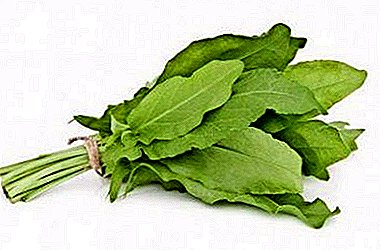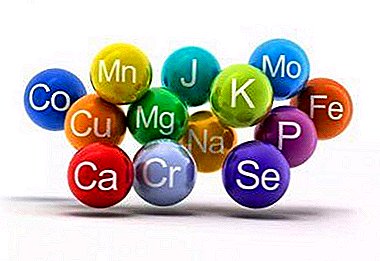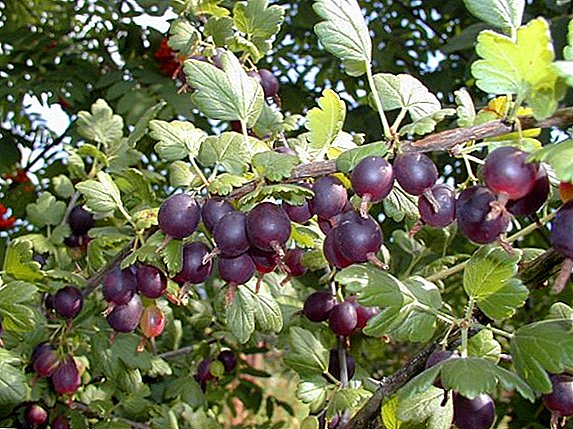
An important condition for the health and youth of the body is the correct acid-base balance. Is sorrel alkaline or acidic? Sorrel is a useful alkaline product, which allows you to avoid the development of many pathological conditions of the body and maintain health until old age, as well as prolong youth.
In the article you can find out what is the caloric content of sorrel per 100 grams, as well as what vitamins are and what trace elements, macronutrients and acids are in it.
The chemical composition of fresh grass
Sorrel has a sour taste, as it contains a large amount of potassium salt of oxalic acid. It also contains citric and malic acids, flavonoids, sugars, tannins, vitamins, as well as trace elements and macronutrients.
What vitamins contain?
What vitamins contain leaves of a plant? Sorrel contains a lot of vitamin C, which strengthens the immune system, and also participates in almost all biochemical processes of the body.
Vitamin K in its composition is responsible for the coagulation process of the blood and is involved in the growth of bone tissue. B vitamins normalize the work of the cardiovascular and nervous systems, strengthen the immune system, participate in cell growth, contribute to the normal functioning of the nervous system and improve the functioning of the intestine.
 Vitamin composition:
Vitamin composition:
- A (beta-carotene) - 2.5 µg;
- C (ascorbic acid) - 47 mg;
- E (tocopherol) - 1.9 mg;
- K (phyllohtnon) - 0.6 mg;
- B1 (thiamine) - 0.06 mg;
- B2 (riboflavin) - 0.16 mg;
- B6 (pyridoxine) - 0.2 mg;
- B7 (biotin) - 0.6 μg;
- B9 (folic acid) - 13.0 µg;
- K (phylloquinone) - 45.0 mcg;
- PP (nicotinic acid) - 0.3-0.5 mg.
Nicotinic acid (vitamin PP) refers to those substances that are not synthesized in the body, so they must be ingested from the outside. This substance is involved in the breakdown of fats and carbohydrates, and also participates in protein metabolism and helps reduce harmful cholesterol, improves blood circulation, strengthens the heart, and also improves memory.
Macronutrients
Macronutrients are necessary for normal human life. Their deficiency can lead to various diseases. In sorrel such macronutrients:
- calcium - 54 mg;
- potassium - 362 mg;
- sodium, 4 mg;
- magnesium - 41 mg;
- phosphorus - 71 mg;
- sulfur - 20 mcg;
- chlorine - 70 mg.
- Potassium and magnesium essential for heart health.
- Calcium and phosphorus strengthen bones, nails and hair.
- Sodium regulates neuromuscular activity.
- Sulfur interferes with the oxidation of tissues at the cellular level, ensures the transmission of genetic information, and also purifies the blood and lymph from toxins and toxins.
Trace elements
Trace elements are a valuable source of essential substances. Sorrel contains such trace elements:
 iodine - 3 µg;
iodine - 3 µg;- copper - 0.2 mg;
- manganese - 0.35 mcg;
- iron 2.4 mg;
- Zinc - 0.5 mg;
- fluorine - 70 mcg.
- Iodine necessary for proper functioning of the thyroid gland, the endocrine, and also the central nervous system.
- Copper participates in the brain and metabolism.
- Manganese valuable in that it is a conductor of other useful substances. Such as copper, vitamins B, vitamins E and C, which are powerful antioxidants.
- Iron It is a part of hemoglobin, which is necessary to provide oxygen to all organs. Iron deficiency provokes the development of anemia, in which all organs suffer from lack of oxygen.
- Zinc stimulates the production of sex hormones, normalizes the pituitary, adrenal glands, testes and ovaries.
- Fluorine prevents caries and regulates blood circulation.
Essential Amino Acids
Irreplaceable acids are not synthesized by the human body on their own, therefore, they must be supplied from the outside with food.
Their lack can provoke malfunctions in the body. They help strengthen muscles and ligaments, increase muscle mass, help restore damaged tissues, and also participate in all body processes.
Sorrel contains such essential amino acids:
- valine - 0.133 g;
- histidine - 0.054 g;
- leucine - 0.167 g;
- isoleucine - 0.102 g;
- lysine - 0.115 g;
- threonine - 0.094 g;
- methionine - 0.035 g;
- phenylalanine - 0.114 g.
- Valin restores muscles and is a good source of energy.
- Histidine helps to improve the functioning of joints, makes the blood more qualitative and has a beneficial effect on muscle growth.
- Isoleucine participates in the production of hemoglobin, monitors blood sugar levels and increases the body's endurance.
- Leucine helps strengthen the immune system and is responsible for the level of leukocytes in the blood.
- Lysine strengthens bone tissue and is responsible for the production of collagen.
- Methionine contributes to the normal functioning of the liver and digestive tract, and also participates in the process of splitting fats.
Replaceable amino acids
 Replaceable amino acids can be produced by the body, so their presence in food is not particularly important. Sorrel contains the following essential amino acids:
Replaceable amino acids can be produced by the body, so their presence in food is not particularly important. Sorrel contains the following essential amino acids:
- arginine - 0.108 g;
- alanine - 0.132 g;
- glycine - 0.114 g;
- aspartic acid - 0.181 g;
- glutamic acid - 0.216 g;
- serine - 0.077 g;
- proline - 0.116;
- Tyrosine - 0.083 g.
- Alanine serves as a source of energy and helps the growth of muscles.
- Glycine promotes muscle function and stabilizes blood pressure, blood glucose, and also participates in the process of splitting fats.
- Serine helps to increase immunity and promotes the release of energy, which is necessary for the rapid metabolism of fatty acids.
- Aspartic acid reduces ammonia levels under heavy loads and speeds up metabolism.
- Glutamic acid helps the brain work.
Calorie, nutritional value and BJU
How many calories in sorrel? Sorrel is a low-calorie dietary product that contains only 22 kcal per hundred grams. Energy value (BZHU):
- proteins - 1.5 g;
- fat - 0.3 g;
- carbohydrates - 2,9g.
Nutritional value per 100g of product:
- dietary fiber - 1.2 g;
- water - 92 g;
- mono and disaccharides - 2.8 g;
- starch - 0.1 g;
- unsaturated fatty acids - 0.1 g;
- saturated fatty acids -0.1 g;
- organic acids - 0.7 g;
- ash - 1.4 g
The chemical composition of cooked herbs
 Fresh sorrel is considered to be the most useful, since the inorganic form of oxalic acid occurs during heat treatment. It can accumulate in the body and lead to the formation of stones in the kidneys and bladder.
Fresh sorrel is considered to be the most useful, since the inorganic form of oxalic acid occurs during heat treatment. It can accumulate in the body and lead to the formation of stones in the kidneys and bladder.
In small quantities oxalic acid does not bear any harm as excreted with urine. Harm to the body can be inflicted only if it is used in large doses. Therefore, do not often cook soup from sorrel, it is better to use it only fresh.
Frozen
With proper freezing in the leaves of sorrel all the beneficial substances are stored, as in a fresh plant. Therefore, the composition of frozen leaves in this case is no different from fresh ones.
Dried
If during drying the sorrel was not exposed to direct sunlight, then the dried product will contain almost all the beneficial substances. As such, it retains its color, taste and beneficial properties.
Different types and varieties
There are many varieties of cultivated sorrel, which practically do not differ in the chemical composition. but There is a plant that many people confuse with sorrel - it's spinach. In appearance, it is very reminiscent of sorrel and has the same ripening time with it. Therefore, it is often mistaken for sorrel.
Differences from spinach
- Sorrel has light green leaves with a sharp finish, and in spinach they are dark green and round.
- Sorrel has a sour taste, as it contains oxalic acid, and spinach is not sour and there is a small bit of bitterness in its taste.
Both plants are low in calories and contain many nutrients. If we compare them in chemical composition, it is worth noting that the first difference in the content of oxalic acid, which is very small in spinach compared to sorrel. There is a lot of protein in spinach - about 2.3%. Its greater content only in legumes, so it is appreciated by supporters of various diets.
What products to combine?
 All foods have a different chemical composition, so they are digested differently in the body. For the processing of the product produced various enzymes. There are foods that have different digestion times. And if you use them together, then the process of proper digestion will be disturbed. Food will not simply rot or roam.
All foods have a different chemical composition, so they are digested differently in the body. For the processing of the product produced various enzymes. There are foods that have different digestion times. And if you use them together, then the process of proper digestion will be disturbed. Food will not simply rot or roam.
The use of compatible products to avoid such problems, it contributes to the full absorption of the nutrients of a product. Sorrel is combined with any products with the exception of milk.
What dishes are best to add?
Sorrel can be added to a variety of dishes, it will enrich their composition with useful substances, as well as improve the taste. For example, it can be added to pies, salads, sauces, omelets, as well as cabbage soup and okroshka. There are even recipes for the preparation of oxalic lemonade and jam.
There are more than two hundred sorrel varieties and only a few of them are used as food and medicinal plants. Translated from the Latin language, its name means "spear". The plant has a rich composition and has a positive effect on the body. However, it is worth remembering that its use in cooked form should be limited.


 iodine - 3 µg;
iodine - 3 µg;









